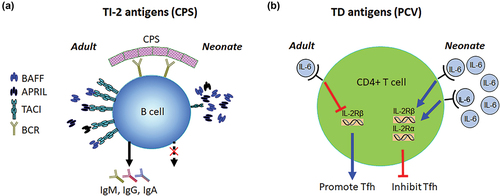Figures & data
Figure 1. Mechanisms of antibody development against unconjugated (a) and conjugated (b) polysaccharide vaccines. (a) in adults, the recognition of multivalent CPSs by BCR on B cells together with BAFF and APRIL mediated signaling through TACI leads to immunoglobulin secretion. In neonates, CPS recognition by BCR is not sufficient to activate B cells because severely reduced expression of TACI on B cells deprives them from the second signal. (b) in adults, IL-6 promotes tfh generation by decreasing the expression of IL-2 Rβ, which spares tfh cells from IL-2 mediated suppression. In sharp contrast to adults, not only neonates harbor more IL-6 after vaccination, but also IL-6 stimulates the expression of IL-2 Rα and IL-2 Rβ on tfh cells, thereby rendering them susceptible to IL-2 mediated suppression.

